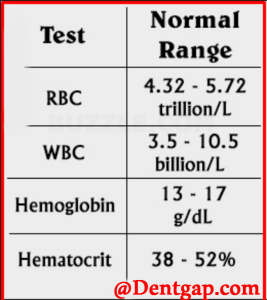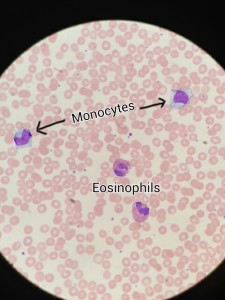White blood cells (WBC) are also known as leukocytes. Protection of the body against diseases and development of hemocytoblasts as a result of hormonal effects, in the red bone marrow area is the main function served by white blood cells. People also talk about WBC normal range.
Hormones are of two types; Interleukins and Colony Stimulating Factors (CSF’s). Interleukins can be categorized as numbers while Colony Stimulating Factors are categorized by their type. The white blood cells travel to the infectious sites and then leave the main blood stream.
WBC normal range mm3 for male, female and child have given below:
| WBC Range: | Values |
|---|---|
| Male: | 3.8 – 11.0 10^3 / mm3 |
| Female: | 3.8 – 11.0 10^3 / mm3 |
| Kid: | 5.0 – 10.0 10^3 / mm3 |
Table of Content
Normal White Blood Cells Functions (WBC Normal Range)
✜ A microliter of human blood consists of approximately 4,500 to 10,000 white blood cells. This is known as white blood cell count. WBC’s count is important for determining clinical conditions of a patient.
✜ The patient is suffering from infection if WBC’s count is higher than normal. Leukocytosis is the condition in which WBC’s exceeds the normal range of 10,000.
✜ Leukemia is a condition that resulting from WBC counts deviations from normalcy.
✜ If WBC count is less than 5,000 cubic millimeter it indicates the presence of leucopenia.
✜ Diseases including measles, influenza, chicken pox, mumps, poliomyletics, typhoid fever and AIDS are associated with leucopenia.
Purpose:
- White blood cells defend the body from germs, viruses, and bacteria.
- The WBC Count test identify the hidden bacterias and virus.
Types of White Blood Cells
There are specifically five types of WBC’s in the blood.
- Leukocytes that appear to be having granular cytoplasm are known as granulocytes. These are double the size of Red blood cells.
- Leukocytes that appear without granular cytoplasm are called agranulocytes.
- Leukocytes having small granules with light purple color at neutral strain are known as neutrophils. These consist of C- shaped nuclei called bands. Neutrophils have the ability to travel and reach the site of injury. Leukocytes are made up of 54 to 62% of neutrophils in adults.
- Monocytes are large sized blood cells almost double the size of RBC’s. These may consist of kidney shaped, oval or round nuclei. Approximately 2 to 8 percent of circulating leukocytes make monocytes.
- Lymphocytes are slightly larger than RBC’s. Around 20 to 30% of circulating leukocytes are made from lymphocytes. These develop immunity system. Antibodies produced by lymphocytes attack against foreign substances. Lymphocytes consists of following;
- T- Cells function is to provide cell- meditated immunity. It is a defense mechanism that protects the cell from infected cell or tissue.
- B Cells provide humoral immunity to cells through production and distribution of antibodies.
- Natural Killer cells function to provide immunity surveillance. It detects the presence of abnormal cell tissues and then functions to remove it.
Significance of WBC’s
Normal white blood cells perform some prime and important physiological functions for the body. One of the major functions it provides is the development of immunity system that protects the body from pathogens etc. WBC’s should be in normal range, excess in range leads to inflammation while decline leads to AIDS.
White blood cells are important for normal functioning of body as they kills parasites and destroys pathogens and also remove worn out or ruptured tissues. WBC normal range should be there. This is important for body to work normal. If white blood cells are not functioning normal body’s immune system is weak and unable to fight against bacterial and other infections.



Recent Comments